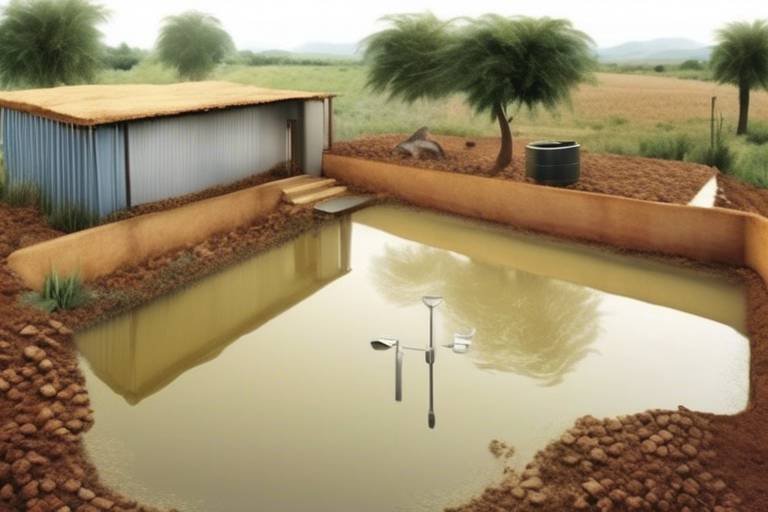The Importance of Water Harvesting in Sustainable Living
Water is the essence of life, and in our rapidly changing world, the importance of sustainable practices cannot be overstated. One such practice that is gaining traction is water harvesting. This method of collecting and storing rainwater not only helps in conserving a precious resource but also plays a pivotal role in promoting environmental sustainability. Imagine a world where every drop of rain is captured and utilized effectively—this is not just a dream but a reality that can be achieved through water harvesting.
Water harvesting has been practiced for centuries, with ancient civilizations recognizing its significance long before modern technology came into play. From the intricate systems of the Roman aqueducts to the traditional methods used in rural communities today, the concept has evolved but remains fundamentally the same: capturing rainwater for future use. In contemporary society, where urbanization and climate change pose significant challenges to water availability, the relevance of water harvesting has become more critical than ever.
By implementing water harvesting systems, we can drastically reduce our dependency on groundwater, which is often over-exploited. This approach not only conserves water but also minimizes the risk of flooding during heavy rains. Furthermore, it contributes to the overall health of our ecosystems by ensuring that water is available for plants and animals alike. In essence, water harvesting is a key player in the quest for sustainable living.
As we delve deeper into this topic, you'll discover the myriad benefits that water harvesting brings to individuals, communities, and the environment. From enhancing climate resilience to fostering community engagement, the implications of adopting such practices are profound and far-reaching. So, are you ready to explore how water harvesting can transform our relationship with this vital resource? Let’s dive in!

Understanding Water Harvesting
Water harvesting is an ancient practice that has been used for centuries to collect and store rainwater for various uses. At its core, it’s about capturing the precious droplets that fall from the sky and putting them to good use, rather than letting them flow away and disappear into the ground or drainage systems. Imagine a world where every drop counts—this is the essence of water harvesting. It not only provides a reliable source of water but also plays a pivotal role in promoting sustainability in our communities.
Historically, many civilizations have relied on water harvesting techniques. From the ancient Romans, who constructed intricate aqueducts, to the indigenous peoples of the Americas, who built sophisticated systems to collect rainwater, the practice has proven its worth across different cultures and climates. Today, as we face pressing environmental challenges, the relevance of water harvesting is more significant than ever. It serves as a crucial strategy for enhancing water security and mitigating the impacts of climate change.
In contemporary society, water harvesting is gaining traction as communities seek sustainable solutions to water scarcity. It involves several techniques that can be adapted to fit various environments, from rural areas with vast open spaces to bustling urban centers where every square meter counts. The idea is to create systems that catch rainwater from rooftops, roads, and other surfaces, directing it into storage systems like tanks or underground reservoirs.
Not only does this practice conserve water, but it also reduces dependency on groundwater sources, which are often over-exploited. By integrating water harvesting into our daily lives, we can significantly lessen the burden on municipal water supplies and contribute to a more sustainable future. Furthermore, it minimizes the risk of flooding by controlling runoff, allowing rainwater to be absorbed into the ground rather than overwhelming drainage systems.
To give you a clearer picture of the various methods of water harvesting, here's a simple table that outlines some common techniques:
| Technique | Description | Best Suited For |
|---|---|---|
| Rain Barrels | Simple containers placed under downspouts to collect rainwater from roofs. | Residential areas |
| Cisterns | Large underground tanks that store collected rainwater for later use. | Urban and rural properties |
| Permeable Pavements | Special materials that allow rainwater to seep through and recharge groundwater. | Parks and driveways |
Embracing water harvesting not only helps in managing water resources but also fosters a sense of community. When people come together to implement these systems, they build resilience against droughts and other climate-related challenges. So, the next time you see the rain falling, think about all the possibilities it holds. With a little bit of foresight and effort, we can transform our approach to water management and create a more sustainable world for generations to come.

Benefits of Water Harvesting
Implementing water harvesting systems offers a plethora of advantages that not only benefit individual households but also contribute significantly to the environment and society as a whole. One of the most compelling benefits is the conservation of water. By capturing and storing rainwater, we can reduce our reliance on traditional water supply sources, which is crucial in areas facing water scarcity. Imagine a world where every drop counts; that's the reality water harvesting helps create.
Moreover, water harvesting plays a pivotal role in reducing dependency on groundwater. Over-extraction of groundwater has led to alarming depletion rates, and this method offers a sustainable alternative. By utilizing rainwater, we can help replenish our aquifers, ensuring a more balanced water cycle. This not only secures our water supply but also minimizes the risk of land subsidence that often accompanies excessive groundwater extraction.
Another significant advantage of water harvesting is its ability to minimize flood risks. During heavy rainfall, stormwater runoff can lead to flooding, causing damage to infrastructure and homes. Water harvesting systems, such as rain barrels and cisterns, can effectively capture this excess rainwater, reducing the volume of runoff and consequently lowering the risk of flooding. Think of it as a safety net for our communities, providing a buffer against the unpredictable nature of weather.
In addition to these practical benefits, water harvesting contributes to environmental sustainability. It supports the natural water cycle and helps maintain local ecosystems. For instance, when rainwater is harvested and used effectively, it can replenish local rivers and streams, providing vital resources for wildlife. This interconnectedness is crucial for preserving biodiversity, as many species rely on consistent water sources for survival.
Water harvesting positively affects ecosystems by replenishing groundwater and maintaining natural water cycles. This practice is not just about collecting water; it’s about nurturing the environment. When we harvest rainwater, we are actively participating in the preservation of our ecosystems. By ensuring that our water sources remain sustainable, we help prevent soil erosion, which can lead to loss of arable land and negatively affect agriculture.
In an era of climate change, water harvesting enhances community resilience. As weather patterns become increasingly unpredictable, the ability to capture and store rainwater can be a game changer. During prolonged dry spells, harvested rainwater can provide a much-needed source of irrigation for crops, ensuring food security. This resilience is not just beneficial for farmers; it ripples through the entire community, creating a buffer against the harsh realities of climate change.
Urban areas face unique water challenges, such as increased pollution and stormwater runoff. Water harvesting techniques, such as green roofs and permeable pavements, can significantly improve urban water management. These innovative solutions not only capture rainwater but also filter it, reducing the burden on municipal water systems. By implementing these techniques, cities can create a more sustainable urban environment that benefits both residents and local wildlife.
In summary, the benefits of water harvesting are multifaceted and profound. From conserving precious water resources to enhancing community resilience and protecting the environment, this practice holds immense potential for fostering sustainable living. As we move forward, embracing water harvesting can be a crucial step towards a greener, more sustainable future.
- What is water harvesting? Water harvesting is the practice of collecting and storing rainwater for future use, helping to conserve water resources.
- How does water harvesting benefit the environment? It helps replenish groundwater, supports local ecosystems, and reduces stormwater runoff, which can lead to flooding.
- Can water harvesting be implemented in urban areas? Yes, urban areas can benefit from innovative techniques like green roofs and permeable pavements to manage water effectively.
- Is rainwater safe to use for drinking? With proper filtration and treatment, rainwater can be made safe for drinking and other household uses.

Environmental Impact
Water harvesting is not just a method of collecting rainwater; it serves as a critical tool for enhancing our environmental health. By capturing and utilizing rainwater, we can significantly contribute to the replenishment of groundwater resources, which are essential for maintaining the natural water cycle. This process plays a vital role in ensuring that our ecosystems thrive, as it helps to sustain local flora and fauna. When we think about the impact of water harvesting, we can liken it to a well-timed rain shower in a parched landscape—providing relief and rejuvenation to the surrounding environment.
One of the most significant benefits of water harvesting is its ability to prevent soil erosion. When rainwater is allowed to flow freely without any management, it can lead to the washing away of valuable topsoil, which is crucial for agriculture and plant growth. By implementing water harvesting techniques, we can control the flow of rainwater, allowing it to seep into the ground rather than rushing off into storm drains. This not only preserves the soil but also helps in maintaining the health of our ecosystems.
Moreover, water harvesting directly contributes to biodiversity. Healthy ecosystems rely on a delicate balance of water, nutrients, and living organisms. By ensuring that water is available during dry spells, we support a variety of plant and animal species that depend on consistent moisture levels. This is particularly important in urban areas, where natural habitats are often disrupted. When we harvest rainwater, we create small pockets of resilience that can sustain wildlife, even in the face of urban development.
Additionally, water harvesting can help mitigate the effects of flooding. In many regions, heavy rainfall can overwhelm drainage systems, leading to flash floods that can devastate communities. By capturing and storing rainwater, we can reduce the volume of runoff that contributes to flooding. This not only protects human lives and property but also safeguards the natural landscape from the destructive forces of uncontrolled water flow.
To summarize the environmental impact of water harvesting, consider the following key points:
- Replenishes groundwater: Supports the natural water cycle and maintains aquifer levels.
- Prevents soil erosion: Controls runoff and preserves topsoil health.
- Enhances biodiversity: Provides essential moisture for various plant and animal species.
- Mitigates flooding: Reduces runoff and protects communities from flood risks.
In conclusion, the environmental impact of water harvesting is profound and multi-faceted. By adopting these practices, we not only enhance our own sustainability but also contribute to the health of our planet. In an age where climate change poses significant threats to our ecosystems, embracing water harvesting can be seen as an act of stewardship—one that ensures a more resilient and thriving environment for generations to come.
Q: What is water harvesting?
A: Water harvesting is the practice of collecting and storing rainwater for future use, which can help conserve water and reduce dependency on traditional water sources.
Q: How does water harvesting benefit the environment?
A: It replenishes groundwater, prevents soil erosion, enhances biodiversity, and mitigates flooding, contributing to overall environmental sustainability.
Q: Can water harvesting be implemented in urban areas?
A: Yes, urban areas can benefit greatly from innovative water harvesting techniques, such as rain gardens, green roofs, and permeable pavements, which promote green infrastructure.
Q: Is water harvesting effective in combating climate change?
A: Absolutely! Water harvesting enhances community resilience by providing a reliable water source during droughts and unpredictable weather patterns.

Climate Resilience
In today's world, where climate change looms large, the concept of has become more important than ever. Water harvesting plays a pivotal role in enhancing the resilience of communities against the unpredictable whims of Mother Nature. Imagine a community that has the ability to withstand prolonged droughts or sudden floods, all thanks to the strategic collection and storage of rainwater. It's like having a safety net that catches you when the weather takes an unexpected turn.
One of the most significant advantages of water harvesting is its ability to mitigate the effects of drought. When rainwater is captured and stored, it provides a reliable source of water during dry spells. This not only supports drinking water needs but also sustains agriculture, ensuring that crops continue to flourish even when rainfall is scarce. Think of it as a savings account for water—when times are tough, you can dip into your reserves instead of relying solely on unpredictable rainfalls.
Moreover, water harvesting can significantly reduce the risk of flooding. By collecting rainwater, communities can manage runoff more effectively, preventing the overwhelming surge of water that often leads to flooding. This proactive approach not only protects homes and infrastructure but also safeguards local ecosystems. When rainwater is allowed to seep into the ground rather than rushing into storm drains, it replenishes groundwater supplies and maintains the natural water cycle.
To illustrate the impact of water harvesting on climate resilience, consider the following table that highlights its benefits:
| Benefit | Description |
|---|---|
| Drought Mitigation | Provides a reliable water source during dry periods, supporting agriculture and drinking needs. |
| Flood Prevention | Reduces runoff by capturing rainwater, minimizing the risk of flooding in urban areas. |
| Groundwater Recharge | Enhances aquifer levels by allowing rainwater to seep into the ground, maintaining natural water cycles. |
In addition to these benefits, water harvesting systems can also foster a sense of community resilience. When individuals and families come together to implement water harvesting practices, they not only improve their own circumstances but also contribute to a collective effort that strengthens the entire community. This shared responsibility can lead to a deeper understanding of water conservation and a stronger commitment to sustainable living.
Ultimately, the integration of water harvesting into our daily lives is not just a method of water management; it's a crucial step towards building a sustainable future. By investing in these systems, we can create communities that are not only resilient to climate change but also capable of thriving in the face of environmental challenges. As we navigate through this era of uncertainty, let’s remember that every drop counts, and every effort towards water harvesting is a step towards a more secure and sustainable world.
- What is water harvesting? Water harvesting is the practice of collecting and storing rainwater for future use, helping to conserve water and manage resources effectively.
- How does water harvesting help during droughts? By capturing rainwater, communities can have a reliable water supply during dry periods, supporting both agricultural and personal water needs.
- Can water harvesting prevent flooding? Yes! By managing runoff through water harvesting, communities can reduce the risk of flooding, protecting homes and infrastructure.
- What are some common techniques for water harvesting? Common techniques include rain barrels, cisterns, and permeable pavements that allow water to infiltrate the ground.

Urban Applications
Urban areas are often plagued by a multitude of water-related challenges, ranging from scarcity to flooding. As cities continue to expand, the need for innovative solutions becomes even more pressing. This is where water harvesting shines as a beacon of hope. By implementing effective water harvesting techniques, urban environments can not only manage their water resources more sustainably but also enhance their overall resilience against climate change.
One of the most exciting aspects of water harvesting in urban settings is the integration of green infrastructure. This approach involves using natural processes and systems to manage stormwater and improve water quality. For instance, rain gardens and bioswales are designed to capture and filter rainwater while allowing it to percolate into the ground. These features not only reduce runoff but also provide aesthetic benefits and habitat for local wildlife. Imagine walking through a city park where rainwater is effectively managed, creating a vibrant ecosystem right in the heart of the urban jungle!
Another innovative technique is the use of permeable pavements, which allow rainwater to seep through surfaces like driveways and parking lots. This not only helps recharge groundwater but also minimizes the risk of flooding during heavy rains. By replacing traditional impermeable surfaces with permeable alternatives, cities can significantly reduce the burden on their drainage systems. It’s like giving urban landscapes a chance to breathe!
Moreover, rooftop rainwater harvesting systems offer a fantastic opportunity for urban dwellers. These systems collect rainwater from rooftops and store it in tanks for later use. This method not only conserves water but can also reduce water bills for residents. Imagine having a self-sustaining water source right on your roof, ready to nourish your garden or flush your toilets! It’s a win-win situation for both homeowners and the environment.
To further illustrate the impact of urban water harvesting, consider the following table that highlights some key benefits:
| Benefit | Description |
|---|---|
| Flood Mitigation | Reduces surface runoff and prevents urban flooding during heavy rainfall. |
| Water Conservation | Decreases dependency on municipal water supply by utilizing harvested rainwater. |
| Groundwater Recharge | Enhances aquifer levels by allowing rainwater to infiltrate into the ground. |
| Improved Aesthetics | Creates green spaces that enhance the beauty and livability of urban areas. |
In conclusion, the application of water harvesting techniques in urban areas is not just a trend; it’s a necessary step towards sustainable living. By embracing these methods, cities can tackle their water challenges head-on while creating a healthier environment for residents and wildlife alike. So, the next time it rains, think about how that precious water can be harnessed to create a greener, more sustainable urban landscape!
1. What is water harvesting?
Water harvesting is the process of collecting and storing rainwater for future use, which can help conserve water and reduce dependence on traditional water sources.
2. How does water harvesting benefit urban areas?
It helps mitigate flooding, conserves water, recharges groundwater, and enhances urban aesthetics by integrating green infrastructure.
3. Can I implement water harvesting at home?
Absolutely! Homeowners can install rooftop rainwater harvesting systems or create rain gardens to capture and use rainwater effectively.
4. What are some common techniques for water harvesting?
Common techniques include rain barrels, cisterns, permeable pavements, and infiltration basins.
5. Is water harvesting legal in urban areas?
Yes, but laws and regulations vary by location. It's essential to check local guidelines before implementing a water harvesting system.

Community Engagement
Community engagement is not just a buzzword; it’s the heartbeat of successful water harvesting initiatives. When local populations are involved, the chances of sustainability soar. Imagine a neighborhood where everyone understands the importance of conserving water and actively participates in harvesting rainwater. It’s like planting seeds of change that blossom into a culture of sustainability. So, how do we foster this engagement? It starts with education and awareness. Workshops, seminars, and community meetings can serve as platforms for sharing knowledge about the benefits of water harvesting. By illustrating how these practices can lead to tangible savings on water bills and contribute to a healthier environment, we can motivate individuals to take action.
Moreover, hands-on activities can significantly enhance community involvement. Organizing events like rain barrel workshops or community clean-up days not only educates but also builds camaraderie among residents. When people work together, they develop a sense of ownership and responsibility toward their environment. This is crucial because, without community buy-in, even the most well-designed water harvesting systems can fall short of their potential.
Another effective approach is to showcase success stories from within the community. When residents see their neighbors successfully implementing water harvesting techniques, it creates a ripple effect. They start to think, "If they can do it, so can I!" This social proof can be incredibly powerful. Additionally, leveraging social media platforms to share tips, progress, and results can keep the momentum going. Imagine a community Facebook group where members post pictures of their rain barrels or share their water conservation achievements. It’s a great way to celebrate successes and inspire others.
Lastly, partnerships with local organizations, schools, and businesses can amplify efforts. Collaborating with schools to incorporate water conservation education into their curriculum can shape the mindset of future generations. Local businesses can also play a role by offering discounts on water-saving products or sponsoring community events. It’s a win-win situation: businesses gain visibility while the community benefits from increased resources.
In conclusion, community engagement in water harvesting initiatives is essential for fostering a culture of sustainability. By educating, involving, and celebrating the efforts of local residents, we can create a thriving ecosystem where water conservation is not just a practice but a way of life.
- What is water harvesting? Water harvesting is the process of collecting and storing rainwater for future use, which can help conserve water and reduce dependency on groundwater.
- How can my community get involved in water harvesting? Communities can engage through educational workshops, hands-on activities, and partnerships with local organizations to promote water conservation practices.
- What are some benefits of water harvesting? Water harvesting helps conserve water, reduces flood risks, replenishes groundwater, and supports community resilience against climate change.
- Are there any specific techniques for water harvesting? Yes, popular techniques include rain barrels, cisterns, permeable pavements, and groundwater recharge methods like infiltration basins.

Techniques for Water Harvesting
Water harvesting is an essential practice that enables us to collect and store rainwater effectively. By employing various techniques, we can maximize our water resources and contribute to a more sustainable future. One of the most popular methods is the use of rain barrels, which are containers placed strategically to collect rainwater from rooftops. These barrels can be a simple DIY project or purchased pre-made, making them accessible for many households. Not only do they help in conserving water, but they also reduce runoff, which can lead to erosion and water pollution.
Another effective technique is the installation of cisterns. Cisterns are larger storage tanks that can hold significant amounts of water, making them ideal for homes and businesses that require a substantial water supply. They can be placed underground or above ground, depending on space and aesthetic preferences. The water collected in cisterns can be used for irrigation, flushing toilets, or even for drinking purposes if properly filtered and treated. This versatility makes cisterns a valuable addition to any water harvesting system.
Moreover, permeable pavements are gaining popularity in urban areas. These innovative surfaces allow rainwater to seep through, reducing runoff and replenishing groundwater supplies. By replacing traditional concrete or asphalt with permeable materials, cities can effectively manage stormwater while creating more green spaces. This not only enhances the beauty of urban environments but also supports local ecosystems by maintaining the natural water cycle.
In addition to these techniques, there are also groundwater recharge methods that play a crucial role in water sustainability. Techniques such as infiltration basins and recharge wells are designed to facilitate the movement of surface water into underground aquifers. Infiltration basins are shallow depressions that capture runoff, allowing it to percolate into the ground. Recharge wells, on the other hand, are drilled into the ground to introduce water directly into aquifers. Both methods are vital for maintaining aquifer levels, especially in areas experiencing over-extraction of groundwater.
When considering which technique to implement, it’s important to assess your local environment, climate, and specific water needs. Each method has its own set of advantages and challenges, and often, a combination of techniques can yield the best results. For instance, utilizing rain barrels alongside permeable pavements can significantly enhance water conservation efforts while improving the overall health of local ecosystems.
- What is the best method for water harvesting in urban areas? Urban areas benefit greatly from techniques like permeable pavements and rain barrels, which help manage stormwater and reduce runoff.
- How can I ensure the water collected is safe for drinking? To make harvested rainwater safe for drinking, it’s essential to filter and treat it properly, using systems designed for potable water.
- Are there any regulations regarding water harvesting? Regulations vary by location, so it’s important to check with local authorities to ensure compliance with any laws or guidelines.

Rainwater Collection Systems
Rainwater collection systems are becoming increasingly essential in our quest for sustainability. Imagine harnessing the very drops of water that fall from the sky, transforming them into a resource that can nourish our gardens, flush our toilets, and even provide drinking water when properly filtered. This practice not only conserves precious water but also reduces stormwater runoff, which can lead to erosion and pollution in our waterways. By implementing these systems, individuals and communities can take a significant step towards self-sufficiency and resilience in the face of climate change.
At the heart of rainwater collection systems are several key components that work together to capture, store, and utilize rainwater effectively. Typically, these systems include:
- Catchment Area: This is usually the roof of a building where rainwater is first collected. The material of the roof can influence the quality of the water, so it's essential to consider using non-toxic roofing materials.
- Gutters and Downspouts: These are essential for directing the rainwater from the catchment area to the storage system. Proper maintenance is crucial to prevent blockages that can diminish efficiency.
- Storage Tanks: Rainwater is stored in tanks, which can be above or below ground. The size of these tanks can vary based on the amount of rainfall in the area and the intended use of the water.
- Filtration System: To ensure that the collected rainwater is safe for use, especially for drinking, a filtration system is necessary. This can include simple mesh filters to more complex purification systems.
When designing a rainwater collection system, several considerations come into play. First, you need to assess your local rainfall patterns to estimate how much water you can realistically collect. Next, consider your household's water needs—how much water do you use daily, and how much of that can be supplemented with rainwater? This will help you determine the size of your storage tank.
Maintenance is another crucial factor. Regularly cleaning gutters, inspecting storage tanks, and ensuring the filtration system is functioning properly are all essential to keep the system running smoothly. Neglecting these tasks can lead to contamination or inefficient water collection, which defeats the purpose of the system.
Integrating rainwater collection systems into homes and businesses not only promotes sustainability but also offers economic benefits. By reducing reliance on municipal water supplies, individuals can save on water bills and lessen the strain on local water resources. Additionally, during periods of drought, having a reliable source of water can be a lifesaver for gardens and landscapes, keeping them vibrant and healthy.
In urban settings, rainwater collection systems can be particularly beneficial. They can help manage stormwater runoff, reducing the risk of flooding and pollution in local waterways. Cities can promote these systems through incentives, making them more accessible to homeowners and businesses alike.
Ultimately, rainwater collection systems are a powerful tool in the fight for sustainability. They empower individuals and communities to take control of their water resources, promote efficient water use, and contribute to a healthier environment. As we face increasing challenges related to water scarcity and climate change, embracing these systems is not just a choice; it's a necessity.
1. Is rainwater safe to drink?
Yes, rainwater can be safe to drink if it is properly collected and filtered. A good filtration system is crucial for removing any contaminants.
2. How much rainwater can I collect?
The amount of rainwater you can collect depends on your roof size and local rainfall patterns. A simple calculation can help estimate potential collection.
3. Do I need a permit to install a rainwater collection system?
Regulations vary by location. Check with your local government to determine if you need a permit for installation.
4. What maintenance is required for rainwater collection systems?
Regular maintenance includes cleaning gutters, inspecting storage tanks, and ensuring the filtration system works correctly.
5. Can rainwater collection systems help during droughts?
Absolutely! They provide an alternative water source that can be crucial during periods of low rainfall.

Groundwater Recharge Methods
Groundwater recharge is a critical component of sustainable water management, and it involves methods that help replenish aquifers and maintain water levels. Imagine your aquifer as a giant sponge that needs to be kept moist to function effectively. When we talk about groundwater recharge methods, we're essentially discussing ways to ensure that this sponge remains hydrated, especially in times of drought or when surface water is scarce. There are several techniques available, each with its unique benefits and applications, depending on the environment and specific community needs.
One of the most effective methods is the use of infiltration basins. These are shallow, excavated areas that allow rainwater to collect and gradually seep into the ground. Think of it as creating a small pond that naturally filters the water as it percolates through the soil. Infiltration basins not only recharge groundwater but also help reduce surface runoff, which can lead to flooding and soil erosion. They are particularly effective in urban areas where impervious surfaces dominate.
Another popular technique is the installation of recharge wells. These wells are designed to direct excess surface water into the groundwater system. When it rains heavily, instead of letting that water run off into storm drains, it can be channeled directly into these wells. Recharge wells are particularly beneficial in areas with high groundwater demand, as they can significantly increase the amount of water available for consumption and irrigation.
In addition to these methods, permeable pavements have gained popularity in urban planning. These innovative surfaces allow water to flow through them, filtering it back into the ground rather than letting it run off into drainage systems. Picture walking on a driveway made of porous bricks that soak up the rainwater, replenishing the groundwater below. This not only helps recharge aquifers but also reduces the heat island effect commonly seen in cities.
To give you a clearer understanding of these methods, here’s a quick comparison table:
| Method | Description | Benefits |
|---|---|---|
| Infiltration Basins | Shallow excavated areas for rainwater collection. | Reduces runoff, prevents flooding, and recharges groundwater. |
| Recharge Wells | Wells that direct surface water into aquifers. | Increases groundwater supply and mitigates drought effects. |
| Permeable Pavements | Porous surfaces allowing water to infiltrate. | Reduces runoff, improves water quality, and recharges groundwater. |
Implementing these groundwater recharge methods requires a collaborative effort from both local governments and community members. By investing in these sustainable practices, we not only enhance our water security but also contribute to the overall health of our ecosystems. After all, maintaining a balanced water cycle is crucial for our survival and the environment.
- What is groundwater recharge? Groundwater recharge is the process of replenishing aquifers by allowing water to infiltrate the ground through various methods.
- Why is groundwater recharge important? It helps maintain water levels in aquifers, supports ecosystems, and provides a reliable water source during dry periods.
- What are some common groundwater recharge methods? Common methods include infiltration basins, recharge wells, and permeable pavements.
- How can communities get involved in groundwater recharge initiatives? Communities can participate by advocating for sustainable practices, supporting local policies, and implementing recharge methods in their own properties.
Frequently Asked Questions
- What is water harvesting?
Water harvesting is the process of collecting and storing rainwater for future use. It's a sustainable practice that helps conserve water and reduces reliance on traditional water sources.
- What are the benefits of implementing water harvesting systems?
Implementing water harvesting systems offers numerous advantages, including conserving water, reducing dependency on groundwater, minimizing flood risks, and enhancing environmental sustainability.
- How does water harvesting impact the environment?
Water harvesting positively affects ecosystems by replenishing groundwater, maintaining natural water cycles, preserving biodiversity, and preventing soil erosion.
- Can water harvesting help with climate resilience?
Absolutely! In an era of climate change, water harvesting enhances community resilience by mitigating drought effects and supporting agriculture during unpredictable weather patterns.
- What techniques are commonly used for water harvesting?
Common techniques for water harvesting include rain barrels, cisterns, permeable pavements, and various groundwater recharge methods. Each method is suited for different environments and needs.
- How can urban areas benefit from water harvesting?
Urban areas can implement innovative water harvesting techniques to promote green infrastructure, improve urban water management, and address unique water challenges faced in cities.
- Why is community engagement important in water harvesting initiatives?
Community involvement is vital for the success of water harvesting initiatives. Educating and engaging local populations fosters a sense of ownership and encourages sustainable practices.
- What are rainwater collection systems?
Rainwater collection systems are setups designed to capture and store rainwater, maximizing water capture for household or business use. They include design considerations and require regular maintenance.
- What methods are used for groundwater recharge?
Groundwater recharge methods include infiltration basins and recharge wells. These techniques are crucial for maintaining aquifer levels and ensuring a sustainable water supply.



















